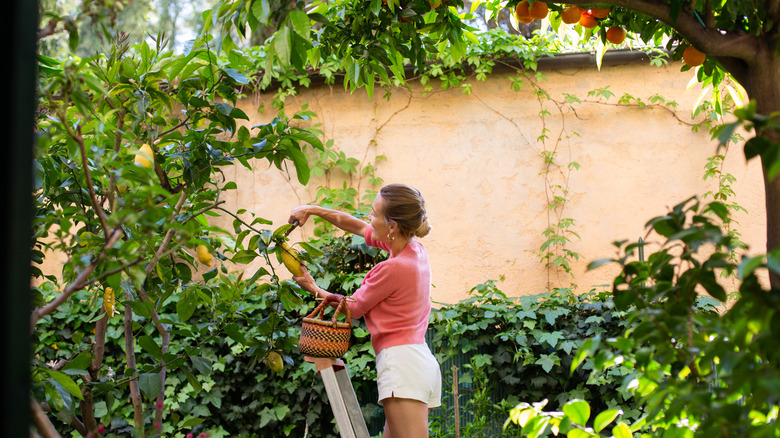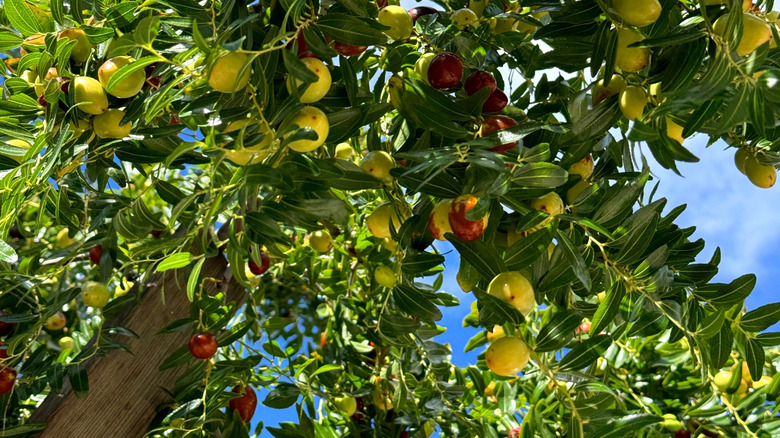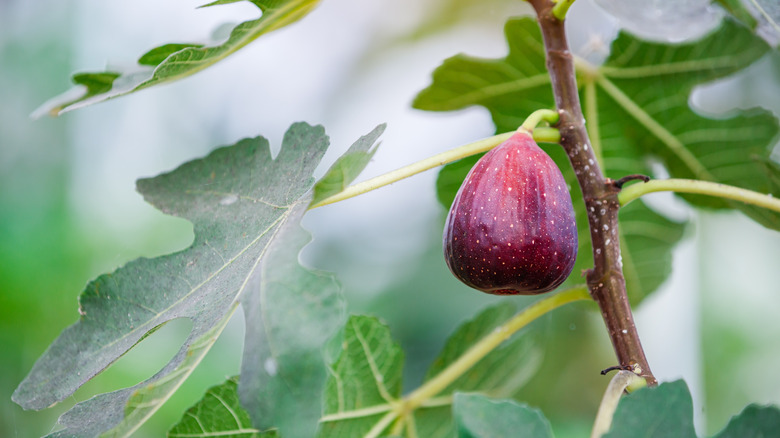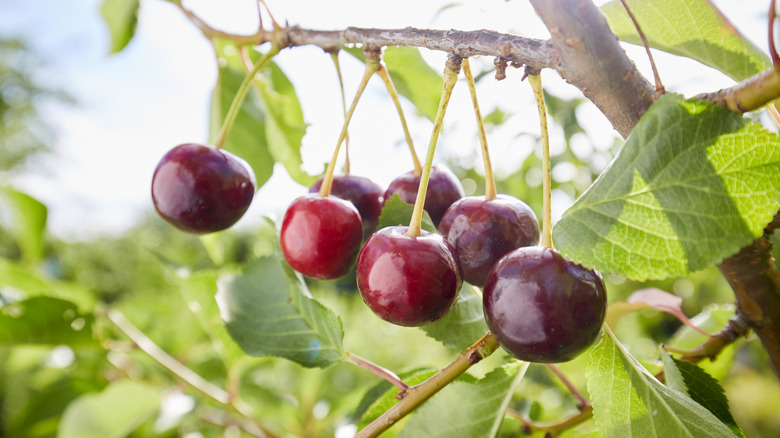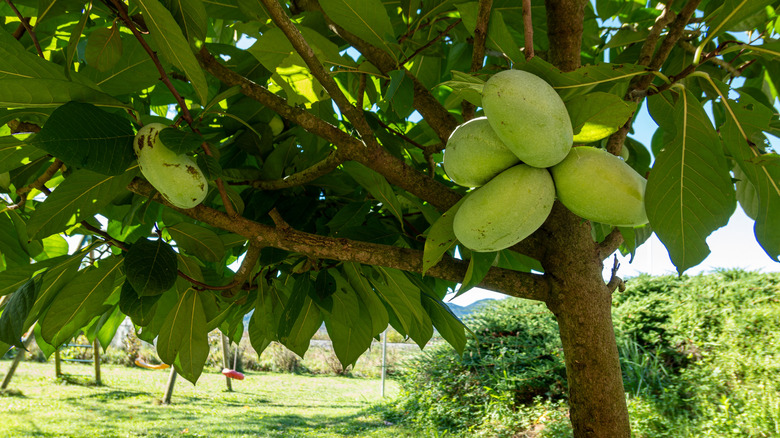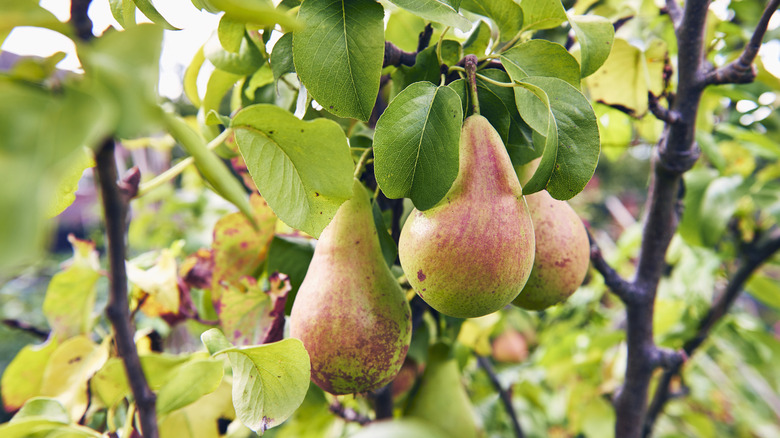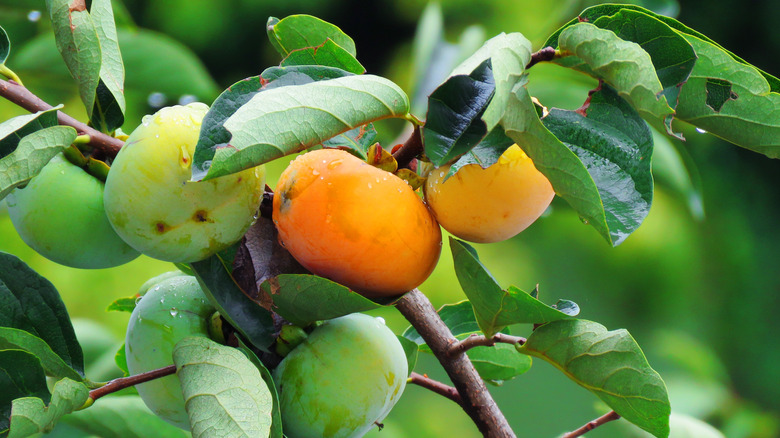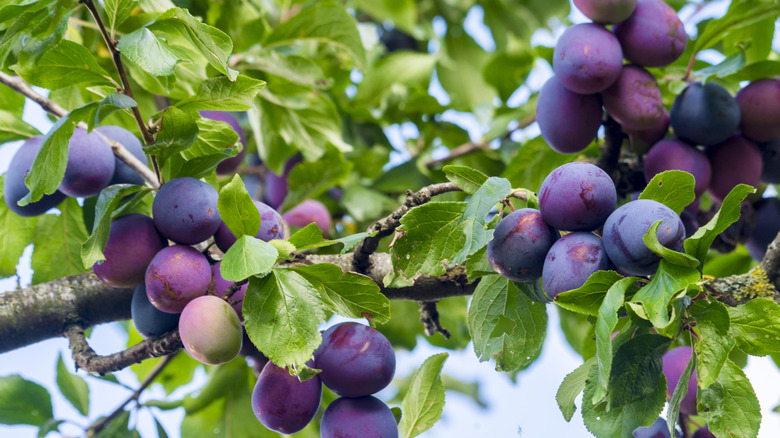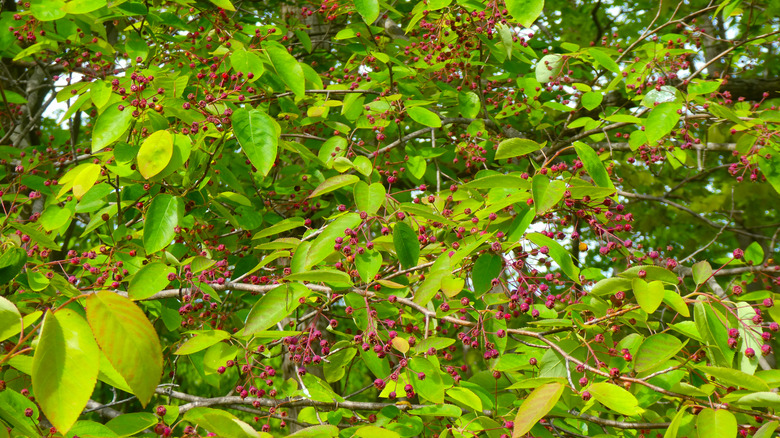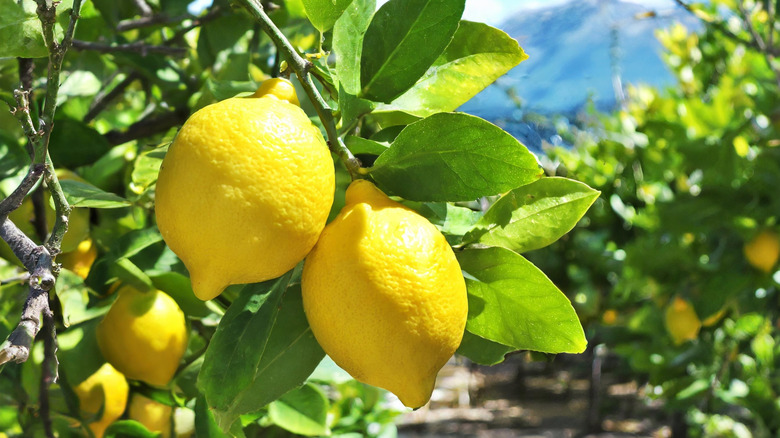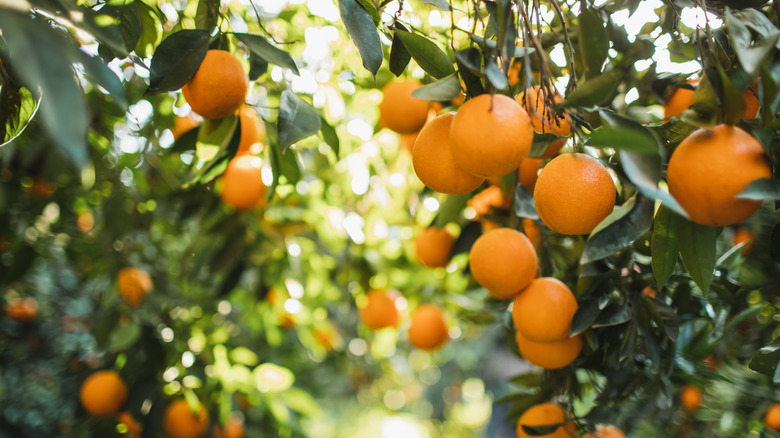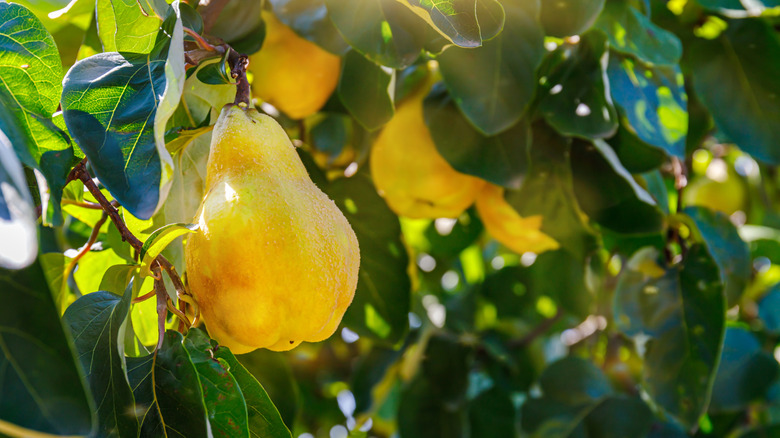11 Fruit Trees That Even A Beginning Gardener Can Grow In Their Yards
Few things compare to the taste of fruit picked fresh from your own backyard. Homegrown produce can be grown organically if you'd like, and a lot of gardeners agree that it's noticeably more flavorful. Fruit trees are also great for wildlife, with many providing nectar for pollinators and sturdy branches for birds to nest or perch. While some fruit trees can be fussy and high-maintenance, there are plenty of options that are great for beginners. In fact, many popular fruit trees come in beginner-friendly cultivars that are more pest- and disease-resistant, drought-tolerant, or compact enough to grow in small spaces. You might be surprised to learn that your favorite fruit has an easy-to-grow option.
First, there are some things you should consider before planting a fruit tree in your backyard. Do you want fruit you can eat right off the tree, or are you more excited about baking, canning, or making jams? Are there any tasks you'd really prefer to avoid, like extensive pruning, managing pests, or keeping up with plants that need regular watering? Some trees are self-unfruitful, meaning they require pollination from another tree of the same species to bear fruit. So, if you don't have the space for multiple trees, then make sure to choose a self-fertile variety that doesn't need a pollination partner. Taking a few minutes to figure out what fits your lifestyle will make the growing process far more enjoyable, especially if you're new to gardening.
Jujube trees tolerate drought with ease and have few pest issues
If you're looking for a hardy tree that practically takes care of itself, look no further than the Jujube tree (Ziziphus Jujuba). Sometimes referred to as the Chinese date, its fruit is crisp and apple-like when fresh, and chewy and sweet like a date when dried. Once established, this drought-tolerant tree can handle temperatures ranging from over 100 degrees Fahrenheit down to 10 degrees. There are virtually no pest issues when growing them in the United States, so pesticides aren't required, and bugs don't get to the fruit before you do. Many cultivars are self-pollinating, but planting two can often boost your fruit yield.
Jujube trees are generally hardy in USDA hardiness zones 6 to 9. While they prefer full sun and well-drained, neutral to slightly alkaline, sandy soils, they can adapt to nearly any soil type. These fast-growers generally reach 8 to 40 feet tall, so they can be a great choice for small backyards, especially if you opt for a dwarf variety, like 'Li 2'.
Fig trees have few pest issues and require little to no pruning
Although you'll have to wait for many species, there are a few fruit trees that produce the first year after transplanting. One notable option is the common fig (Ficus carica), which has the bonus of being self-fertile, so you only need one to start harvesting. Even better, they're incredibly low-maintenance, so you can enjoy your delicious, home-grown figs without the extra heavy lifting. You won't need to fertilize them often, if at all, and overfeeding them can actually reduce yields by encouraging leaf growth instead of fruit. Minimal pruning is required for figs; just remove dead or damaged branches and shape as needed to train or encourage growth. Producing nutrient-packed fruit with a sweet, honey-like flavor, they make an excellent addition to an edible garden.
Fig trees aren't too picky about soil texture, but prefer rich, slightly acidic to neutral, well-drained soil. As long as it's amended with organic matter, they should grow well without fertilizer. Younger trees will need regular watering, but they become more drought-tolerant once established. However, going without water for too long can cause fruit to drop prematurely. Fig trees are generally hardy in zones 7 to 10 and will need some winter protection, though there are cold-hardy cultivars, like 'Brown Turkey', that can tolerate cooler zones. While fig trees can be 50 feet tall, they rarely exceed 25 feet in home gardens.
Cherry trees don't require thinning
With their nearly year-round ornamental beauty, it's hard to believe cherry trees can be beginner-friendly. There are two types of fruiting cherries to choose from. Sweet cherries (Prunus avium) have a higher sugar content and are indeed sweeter than tart cherries (Prunus cerasus), which are primarily used for cooking. Neither tree has particularly high pruning needs compared to other stone fruit trees, and tart cherries are usually smaller and easier to manage. For the easiest-to-grow cherry trees, opt for disease-resistant cultivars like 'Lapins' for sweet cherries and 'Meteor' for tart cherries.
Grow cherry trees in a sunny area in slightly acidic to neutral, well-drained soil. Because they need a chilling period between 700 to 1,200 hours to produce fruit, they're cold-hardy trees that thrive in zones 4 to 8, depending on the variety. Before purchasing, make sure the variety you choose will get the appropriate chilling period. Tart cherries typically need more chilling hours than sweet cherries. Cherry trees come in a range of sizes, so there's a variety for you whether you prefer a large cloud of pink blooms each season or want something more compact for smaller backyards. Cherry trees don't require thinning, though pruning annually in winter helps manage its shape and encourages the growth of new fruiting wood.
Pawpaw trees are cold-hardy and don't have pest or disease issues
The pawpaw tree (Asimina triloba) is one of the most underrated, easy-going trees you can grow in North America. It's an attractive native that produces exotic-tasting fruit, but without the high-maintenance care or tropical climate that most similar fruits require. They're cold-hardy and relatively pest and disease-free, with even deer usually leaving them alone due to the bitter compounds in the leaves. The main pest you need to look out for is the peduncle borer, which usually doesn't cause a ton of damage, but can cause flower drop in extreme cases. Considered the largest edible fruit native to North America, the pawpaw is known for its custard-like texture and a sweet, tropical mix of flavors like mango, pineapple, and banana.
You can grow pawpaw trees in zones 5 to 9, as they prefer regions with hot summers and cold winters. They're extremely shade-tolerant but tend to produce more fruit in full sun. In the wild, pawpaws are understory trees along streams and woodland edges, so mimic their native habitat by giving young trees some afternoon shade. They like rich, slightly acidic, well-drained soil and regular moisture. One of the biggest mistakes people make when growing fruit trees is disregarding pollination. Unlike self-fertile trees, pawpaws need at least two genetically different trees blooming together to produce fruit. Pawpaws are small trees or large shrubs, reaching about 15 to 30 feet tall and wide.
Pear trees don't need heavy fertilization and have disease-resistant cultivars
For an easy-to-grow option, choose from a variety of European and Asian pears. European pears are likely what you picture when someone says "pear," which feels soft once ripe. They're more winter-hardy and better suited for northern climates, but they're more prone to disease. On the other hand, Asian pears are more apple-shaped and stay crisp when fully ripe. They are less tolerant of extreme cold but are generally more resistant to common fruit tree issues. Fire blight is the main problem pears face, but cultivars like 'Kieffer', 'Harrow Delight', and 'Harvest Queen' are disease-resistant.
Pear trees grow in zones 3 or 4 to 8 and require 400 to 900 chill hours to bloom and fruit. Most pears aren't self-fertile, and even if they are, they typically produce more fruit with a cross-pollinator nearby. Plant them in full sun, and give younger plants weekly water as they establish their roots. You can plant them in nearly any soil type as long as it's well-draining. They don't require heavy fertilizing aside from a nitrogen boost if the growth slows down, which is easy to remedy with a layer of mulch around the base. Common pears grow up to 30 feet tall with a 20-foot spread, though you can find varieties in a wide range of shapes, sizes, and even fruit colors.
Persimmon trees require minimal pruning and are drought-tolerant once established
Persimmon trees (Diospyros virginiana) are not only easy to grow, but a single one of their nutritious fruits delivers over 20 percent of your recommended daily vitamin C intake. While some persimmons can be astringent, there are plenty of sweet and flavorful cultivars available. As long as their basic requirements are met, there isn't much maintenance required for persimmon trees. You'll need to prune young persimmon trees to encourage a strong growth habit, but heavy pruning isn't required as they establish. Just remove any dead branches, cut off suckers, and thin occasionally to promote good air circulation. Aside from the occasional leaf spot, they're resistant to pests and diseases.
Choose a well-drained, organically rich soil and plant them in an area that receives full sun. They can grow in a range of soils, and can even grow in well-drained clays. There are native and Oriental persimmons, so make sure to choose the one best suited for your climate. Most Oriental persimmons can tolerate temperatures of 10 degrees Fahrenheit and above, while native varieties can withstand temperatures down to -25 degrees Fahrenheit. Most Oriental persimmons are self-fertile, but you'll get bigger, more consistent crops if you plant two different cultivars that flower at the same time.
Plums are easy to prune and don't have serious pest issues
There are several types of plum trees to choose from, though European or Japanese types tend to be best for most American gardens. While a lot of plum trees require a second variety, there are self-fertile options, so check before you buy. They benefit from annual pruning but don't require the same level of meticulous pruning as other fruit trees. Many plums aren't typically at risk of critical pest damage, though they're somewhat susceptible to diseases like brown knot or black rot.
Plum trees can be hardy in zones 3 to 9. So, to grow a plum tree in your yard as a beginner gardener, start by choosing a variety suited for your area. 'Green Gage' plum is a good, partially self-fertile option for most gardens, but adding another variety can encourage better fruiting. While they can tolerate most soil types, they thrive in moist, fertile, slightly acidic soil. For the best crop, choose a warm, sheltered site in full sun. Plum varieties have a wide range of chill requirements, so be sure to choose one that matches your climate.
Serviceberry trees tolerate poor conditions and rarely need to be pruned
Popular for providing year-round interest, serviceberry (Amelanchier spp.) is a hardy tree that survives in poor conditions and produces tasty fruit. Nearly all varieties are native to North America, and they attract wildlife like birds, bees, and other pollinators. As resilient plants that naturally grow in the wild, they often succeed where fussier fruit trees fail. They're tolerant of pollution, can grow in poor soils, and are one of the few fruiting trees that can tolerate full shade. Because most are self-fruitful, you won't need to plant another species to get sweet, delicious berries. Aside from fungal issues like entomosporium leaf and berry spot, they don't have any serious pest or disease problems. The best way to prevent an outbreak is by watering at the base and pruning to keep an open canopy.
Serviceberries are incredibly cold-hardy, generally growing well in zones 3 to 9. Although they can tolerate full shade, they prefer moist, well-drained, acidic soil in full sun to partial shade. Most enjoy regular moisture, but you can find varieties that have a higher drought tolerance. They aren't too needy in terms of fertilizer, but you can apply a well-balanced 16-16-16 at the beginning of the growing season to give them a nutritional boost. There are many to choose from, with compact varieties being as small as 4 feet and others growing up to 25 feet tall.
Lemon trees can be forgiving of neglect and need minimal pruning
Lemon trees (Citrus limon) and other citrus trees may be more common down south, but that doesn't mean you can't grow them where you live. If you're outside of their hardiness zone of 9 to 11, you can plant them in containers and grow lemon trees indoors during colder months. For many, they're considered the easiest citrus tree to grow, as they don't require excessive pruning aside from clearing out a few branches here and there for air circulation. Additionally, they self-pollinate, so they'll produce their tart fruits without the help of another plant.
If you're growing lemons in containers, make sure to choose a dwarf variety like 'Eureka Lemon', which is more compact and resistant to disease and pests. Plant your lemon tree in well-drained soil in a sunny area of your yard away from any tall structures that could cast shade. You can keep your lemon tree in the same container for a few years, but check the roots each year and repot when they start growing out of the drainage holes. Most lemons love moist soil and regular feeding, but they can also be surprisingly forgiving of neglect. You may not get your best crop if you slip up on their care for an extended period, but they'll likely survive and bounce back.
Mandarin oranges are disease-resistant and drought-tolerant
The mandarin orange (Citrus reticulata) is a low-maintenance fruit tree that beginners can grow in small spaces, with a naturally compact size that makes it perfect for patio gardening. Although it's another citrus tree that's hardy in zones 9 to 11, you can easily keep container plants outside during the summer and move them indoors or to a greenhouse when temperatures cool. They're generally free of disease, though cultivars like 'Owari' are both pest and disease-resistant. Like lemon trees, mandarin orange trees are self-fertile and will produce an abundance of fruit even if grown alone.
If you're not in its hot and humid growing region, choose a compact variety that will be easy to carry inside as winter approaches. They grow best in sandy, well-drained soils and can tolerate light shade, but will have the best growth in full sun. Most mandarin orange trees are thirsty and benefit from regular, even watering. However, the 'Owari' cultivar is a bit more drought-tolerant once established. These plants love humidity, so place a humidifier nearby or use a spray bottle to mist your tree during the winter.
Quince trees require minimal maintenance and pruning
The quince tree (Cydonia oblonga) is a somewhat overlooked fruiting tree in the United States, but you may want to give this low-maintenance option a try. They produce pome fruits that are quite bitter when eaten fresh off the branch, but they transform beautifully during the cooking process. When cooked, it becomes softer and sweeter, so you can bake it and eat it as is or use it for jams or jellies. While it may be a pome tree, it's a bit different than apples and pears in terms of pruning. Newly planted trees will need similar pruning to apples, but you'll mainly just have to prune dead and diseased branches moving forward.
Quince trees thrive in areas with long, hot summers and are hardy in zones 5 to 8. They'll happily grow in most soils, but well-drained loams are what they prefer. You can plant them in partial shade, but you'll get the best fruit if you choose a location in your yard that receives full sun. Quince trees are relatively pest- and disease-resistant, though they can be affected by fire blight in humid conditions. However, certain cultivars like 'Pineapple,' 'Smyrna,' and 'Mellow' tend to be more resistant to this disease than others. Typically growing about 12 to 15 feet tall, these small trees won't overwhelm your yard.
